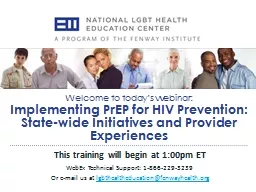PPT-Welcome to today’s webinar:
Author : tatiana-dople | Published Date : 2019-12-14
Welcome to todays webinar Implementing PrEP for HIV Prevention Statewide Initiatives and Provider Experiences This training will begin at 100pm ET WebEx Technical
Presentation Embed Code
Download Presentation
Download Presentation The PPT/PDF document "Welcome to today’s webinar:" is the property of its rightful owner. Permission is granted to download and print the materials on this website for personal, non-commercial use only, and to display it on your personal computer provided you do not modify the materials and that you retain all copyright notices contained in the materials. By downloading content from our website, you accept the terms of this agreement.
Welcome to today’s webinar:: Transcript
Download Rules Of Document
"Welcome to today’s webinar:"The content belongs to its owner. You may download and print it for personal use, without modification, and keep all copyright notices. By downloading, you agree to these terms.
Related Documents














